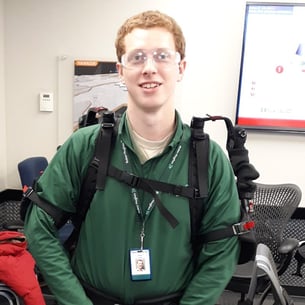Zach is currently a mechanical engineer at Tinker Air Force Base and previously, worked at Baker Hughes in a similar role.
|
Zach, please tell us about your yourself. |
|
 |
My background is in manufacturing engineering, responsible for multiple work cells, in terms of processes, production equipment, and tooling. In my last role, I was on the fast reaction team for our facility. If something needed to get done right the first time, and be done yesterday, it fell on us to engineer the tools and machines needed to stay competitive and win in an ever- more challenging energy market. I grew our additive tooling program from infancy and helped turn it into a program that saved us at least $500K in the first year. Our printed components ran the gambit: production pieces, prototypes, tooling, we did it all. Some tools were not possible without AM as the mode of manufacturing. I'm never going back; AM is the future, the future is here, and it's mind-blowing. |
|
What are your impressions of Metal AM and its capabilities? |
|
|
Metal additive is following the same technical progression of personal PCs in the 90's.... lots of promise, very powerful, absolutely game changing.... and it still has room to grow. Metal AM is production-ready, but in order to complete its clean sweep of the industrial status quo, the industry needs machines that can reliably hit +/- .001" tolerance levels, for thousands of parts. I think VELO3D leads the pack here, they are the equivalent of Microsoft. The Sapphire doesn't require most engineers to change their designs, (which was the former hurdle to full-scale adoption), and it's insanely accurate. In fact, I’ve seen prototypes so accurate that the internal geometries were within spec, without the need to surface or post-machine. |
|
|
What are you most impressed with when it comes to AM? |
|
|
It's a catalyst. It allows the next vanguard of engineers and inventors to truly materialise their visions for the future, without the former limitations imposed by traditional manufacturing. Scale and precision will progress over time, but what truly differentiates AM is its ability to catalyze change in the minds of its users. It teaches you to think without boundaries. That's true empowerment: catalyzing change for the better in our world, by freeing us to consider new possibilities. |
|
|
What needs to happen for more traditional manufacturers to consider metal AM for quality-assured production? |
|
 |
Misconceptions about metal AM are the last major hurdle to full adoption. Metal AM needs to be fire-and-forget. Period. I cannot tell you how many times I have seen serious enthusiasm for AM, up until the realization dawns that you can't just hit a button and walk away. There is forethought involved in terms of material supply, part prep, serialization, and modality selection. There is afterthought involved with dimensionally verifying your generative part, controlling its metallurgy, and providing reliable datums for post machining. While this is old news to SMEs, many professionals are still under the impression that AM is relatively simple. The final barrier is the lack of familiarity with metal AM concepts and rules, from the machine operator all the way up to the CEO. Education in every layer of society on what AM is capable of is required to dispel AM myths and turn it into a panacea. It's time to move away from additive champions, and move towards comprehensive additive knowledge for every manufacturing organization. Our responsibility as SMEs is to educate our cohorts, and before you know it, we will look back with wonder on the paradigm shift we were blessed enough to be part of. |




